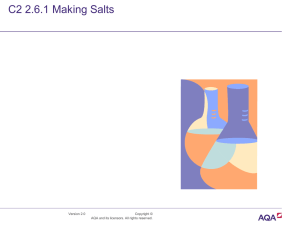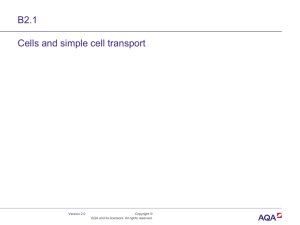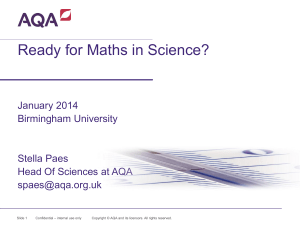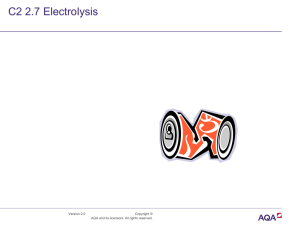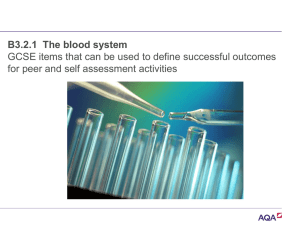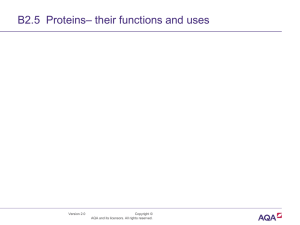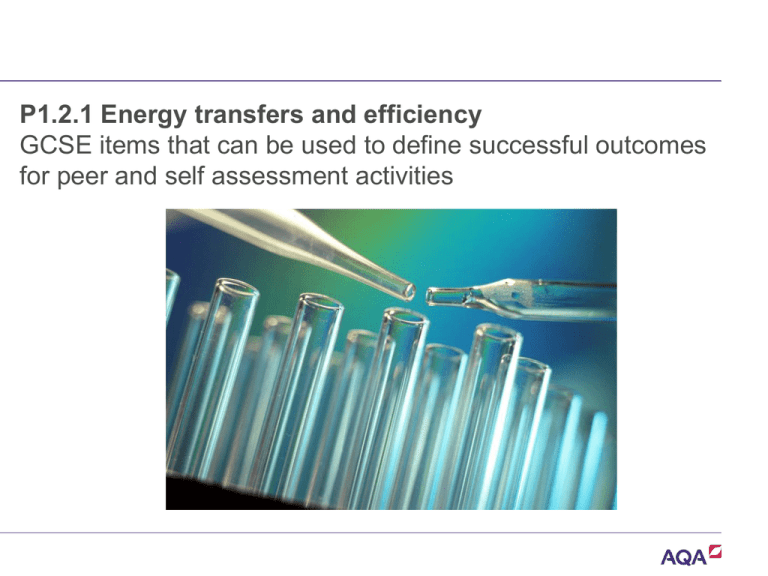
P1.2.1 Energy transfers and efficiency
GCSE items that can be used to define successful outcomes
for peer and self assessment activities
•Assessment of practical work
Using Exam pro items to support successful
outcomes
Learners will be able to test their progress against learning
outcomes using questions taken from past AQA GCSE
questions.
Version 2.0
Copyright © AQA and its licensors.
All rights reserved.
Q1 Foundation AQA-PH1FP-QP-Jun12 Q1
The appliances shown on the next slide transfer electrical
energy to other types of energy.
The vacuum cleaner is designed to transfer electrical
energy to kinetic energy.
a)Name the three other appliances which are also
designed to transfer electrical energy to kinetic energy.
Version 2.0
Copyright © AQA and its licensors.
All rights reserved.
Version 2.0
Copyright © AQA and its licensors.
All rights reserved.
Q1 cont.
b) Which two of the following statements are true?
•A Appliances only transfer part of the energy usefully.
•B The energy transferred by appliances will be destroyed.
•C The energy transferred by appliances makes the
surroundings warmer.
•D The energy output from an appliance is bigger than the
energy input.
Version 2.0
Copyright © AQA and its licensors.
All rights reserved.
Q1 mark scheme
a) Washing machine, fan, drill
1 mark for each 3
b) A C
1 mark for each
Version 2.0
2
Copyright © AQA and its licensors.
All rights reserved.
Q2 Foundation Exampro QM94R505
The diagram shows what happens to each 100 joules of energy from crude oil when it is
used as petrol in a car.
The widths of the arrows show exactly how much energy is transferred in each particular
way.
(a) Complete the diagram by adding the correct energy value alongside each
arrow. (3)
Version 2.0
Copyright © AQA and its licensors.
All rights reserved.
(b) Calculate how efficient the car engine is at transferring
the energy from petrol into useful movement.
[Show your working].
(2)
(c) Two students are discussing the diagram.
The first says that none of the energy released from the
crude oil is really lost.
The other says that all of the energy released from the crude
oil is really lost.
What do you think?
Explain your answer as fully as you can.
(4)
Version 2.0
Copyright © AQA and its licensors.
All rights reserved.
Q2 mark scheme
(a) A = B = 20,
C = 60
3
(b) evidence of or 20%/0.2 gains 1 mark
but 25%/0.25 or figure consistent with B in part (a) gains 2 marks
2
(c) ideas that
“lost” energy is (also) transferred (in ways we don’t want)
total amount of energy (before and after any transfer) remains the same
energy becomes (progressively) more spread out/less easy to transfer again
this applies to all the energy/even to the energy usefully transferred
each for 1 mark
Version 2.0
Copyright © AQA and its licensors.
All rights reserved.
Q3 higher AQA-PH1HP-QP-Jan12 Q 6
The table on the next slide gives data about two types of low
energy bulb.
(a) Both types of bulb produce the same useful power output.
(a) (i) Calculate the useful power output of the CFL.
Use the correct equation from the Physics Equations Sheet.
Show clearly how you work out your answer.
Useful power output = ................................................. W
(2 marks)
Version 2.0
Copyright © AQA and its licensors.
All rights reserved.
Version 2.0
Copyright © AQA and its licensors.
All rights reserved.
Q3 contd.
(a) (ii) Calculate the efficiency of the LED bulb.
Use the correct equation from the Physics Equations Sheet.
Show clearly how you work out your answer.
Efficiency = ......................................................
(1 mark)
Version 2.0
Copyright © AQA and its licensors.
All rights reserved.
Q3 contd.
6 (b) Sketch and label a Sankey diagram for the CFL (2 marks)
6 (c) LED bulbs are expensive. This is because of the large
number of individual electronic LED chips needed to produce
sufficient light from each bulb.
6 (c) (i) Use the data in the table to evaluate the costeffectiveness of an LED bulb compared to a CFL. (2 marks)
6 (c) (ii) Scientists are developing brighter and more efficient
LED chips than those currently used in LED bulbs.
Suggest one benefit of developing brighter and more efficient
LED chips.
(1 mark)
Version 2.0
Copyright © AQA and its licensors.
All rights reserved.
Q3 markscheme
Version 2.0
Copyright © AQA and its licensors.
All rights reserved.
Q3 markscheme contd.
Version 2.0
Copyright © AQA and its licensors.
All rights reserved.
Q3 markscheme contd.
Version 2.0
Copyright © AQA and its licensors.
All rights reserved.

